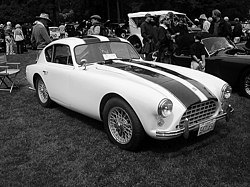AC Aceca
| AC | |
|---|---|
|
AC Aceca
|
|
| Aceca | |
| Production period: | 1954-1963 |
| Class : | Sports car |
| Body versions : | Combi coupe |
| Engines: |
Petrol engines : 2.0-2.6 liters (66-93 kW) |
| Length: | 3899 mm |
| Width: | 1549 mm |
| Height: | |
| Wheelbase : | 2286 mm |
| Empty weight : | 962 kg |
The AC Aceca is a sports car from the British car manufacturer AC Cars . The station wagon coupé was built from 1954 to 1963. Originally the car was equipped with an AC engine, but from 1956 there was also the Aceca-Bristol from the manufacturer Bristol Cars with the same body, but with a Bristol engine. From 1961 to 1963 a few copies were equipped with a tuned 2553 cc engine from the Ford Zephyr and sold as the Aceca 2.6 .
The Aceca was a handcrafted GT of old British tradition based on the 2-seater roadster AC Ace . Its structure consisted of steel pipes and ash wood . Noteworthy was the tailgate that made the Aceca the second British station wagon after the 1953 Aston Martin DB2 / 4 .
151 AC Aceca, 169 Aceca-Bristol and eight cars with Ford engines were built until production was discontinued in 1963.
The main difference between the AC Aceca and the Aceca-Bristol was the engine. Both cars had six-cylinder in-line engines, but the AC Aceca had the 1991 cc engine with overhead cam and 90 bhp (66 kW) output from the AC Ace, while the Aceca-Bristol usually had the 1971 cc D-Type engine 126 bhp (93 kW) was installed by Bristol. Some of the Aceca Bristol cars were also equipped with the weaker B-Type engine with 106 bhp (78 kW). In the USA, the Bristol Aceca was US $ 1000 more expensive than the AC Aceca, which cost US $ 5400. In the UK, the AC Aceca cost £ 1722.
The design of the front of the AC Ace and AC Aceca is said to go back to drawings by Pininfarina from the late 1940s. The cars are relatively light because of their tubular frame, aluminum engine block and aluminum planking. The 16 ″ spoke wheels and the even 50:50 weight distribution between the front and rear axles give the car exceptionally good handling, even on poor roads. The later Aceca (from 1957) were equipped with disc brakes at the front, but all of these cars have transverse leaf springs on the front axle, semi-axles at the rear, worm steering, on request an overdrive for 2nd, 3rd and 4th gear, a curved windshield and leather-covered bucket seats . Front and rear wheels are suspended individually.
Aceca Bristol
The six-cylinder engine of the Aceca-Bristol is based on a design of BMW and has a cast-iron engine block and a cylinder head from aluminum . The single camshaft below operates the rocker arms of the intake valves via vertical bumpers and the exhaust valves via rocker arms, horizontal bumpers in pipes in the cylinder head and other rocker arms. The two cylinder head covers make the engine look similar to an engine with an overhead camshaft . The three interconnected Solex downflow carburetors sit directly between them on the cylinder head .
Driving characteristics
The undercarriages are designed to be pretty tough and cornering stability is very good, with the vehicles prone to oversteer. The short wheelbase is remarkable. The 90 bhp (66 kW) machine works best at high speeds, although the acceleration values are not particularly good. Other shortcomings are inadequate rear-view mirrors, although the rear window allows a good view to the rear, as well as heating that is not suitable for cold winters. In addition, at a speed of 120 km / h or more, it is difficult to talk to the passenger due to the volume. The gear shift is rather stiff and the 1st gear is not synchronized.
Web links
Individual evidence
- ^ A b c d David Culshaw, Peter Horrobin: The Complete Catalog of British Cars . Macmillan, London 1974, ISBN 0-333-16689-2 .
- ^ Michael Sedgwick, Mark Gillies: A – Z of Cars 1945–1970 . Bay View Books, Devon, UK 1986, ISBN 1-870979-39-7 .
- ^ Graham Robson: A – Z British Cars 1945–1980 . Herridge & Sons, Devon, UK 2006, ISBN 0-9541063-9-3 .


